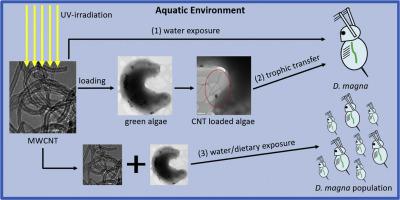NanoImpact ( IF 4.7 ) Pub Date : 2021-03-19 , DOI: 10.1016/j.impact.2021.100303 Irina Politowski 1 , Fabian Wittmers 1 , Michael Patrick Hennig 1 , Nina Siebers 2 , Birgitta Goffart 1 , Martina Roß-Nickoll 1 , Richard Ottermanns 1 , Andreas Schäffer 1

|
Carbon nanotubes (CNT) are promising nanomaterials in modern nanotechnology and their use in many different applications leads to an inevitable release into the aquatic environment. In this study, we quantified trophic transfer of weathered multi-walled carbon nanotubes (wMWCNT) from green algae to primary consumer Daphnia magna in a concentration of 100 μg L−1 using radioactive labeling of the carbon backbone (14C-wMWCNT). Trophic transfer of wMWCNT was compared to the uptake by daphnids exposed to nanomaterials in the water phase without algae. Due to the rather long observed CNT sedimentation times (DT) from the water phase (DT50: 3.9 days (d), DT90: 12.8 d) wMWCNT interact with aquatic organisms and associated to the green algae Chlamydomonas reinhardtii and Raphidocelis subcapitata. After the exposition of algae, the nanotubes accumulated to a maximum of 1.6 ± 0.4 μg 14C-wMWCNT mg−1 dry weight−1 (dw−1) and 0.7 ± 0.3 μg 14C-wMWCNT mg−1 dw−1 after 24 h and 48 h, respectively. To study trophic transfer, R. subcapitata was loaded with 14C-wMWCNT and subsequently fed to D. magna. A maximum body burden of 0.07 ± 0.01 μg 14C-wMWCNT mg−1 dw−1 and 7.1 ± 1.5 μg 14C-wMWCNT mg−1 dw−1 for D. magna after trophic transfer and waterborne exposure was measured, respectively, indicating no CNT accumulation after short-term exposure via trophic transfer. Additionally, the animals eliminated nanomaterials from their guts, while feeding algae facilitated their excretion. Further, accumulation of 14C-wMWCNT in a growing population of D. magna revealed a maximum uptake of 0.7 ± 0.2 μg mg−1 dw−1. Therefore, the calculated bioaccumulation factor (BAF) after 28 d of 6700 ± 2900 L kg−1 is above the limit that indicates a chemical is bioaccumulative in the European Union Regulation REACH. Although wMWCNT did not bioaccumulate in neonate D. magna after trophic transfer, wMWCNT enriched in a 28 d growing D. magna population regardless of daily feeding, which increases the risk of CNT accumulation along the aquatic food chain.
中文翻译:

营养转移研究:与水蚤 Daphnia magna 中的绿藻相关的多壁碳纳米管的积累
碳纳米管 (CNT) 是现代纳米技术中很有前途的纳米材料,它们在许多不同的应用中的使用导致不可避免地释放到水生环境中。在这项研究中,我们使用碳主链的放射性标记 ( 14 C-wMWCNT)量化了风化多壁碳纳米管 (wMWCNT) 从绿藻到主要消费水蚤的营养转移,浓度为 100 μg L -1 。将 wMWCNT 的营养转移与暴露于没有藻类的水相中纳米材料的水蚤的吸收进行比较。由于从水相中观察到的 CNT 沉降时间 (DT) 相当长 (DT 50 : 3.9 天 (d), DT 90: 12.8 d) wMWCNT 与水生生物相互作用并与绿藻莱茵衣藻和Raphidocelis subcapitata相关。藻类暴露后,纳米管在 24 小时后累积至最大值 1.6 ± 0.4 μg 14 C-wMWCNT mg -1干重-1 (dw -1 ) 和 0.7 ± 0.3 μg 14 C-wMWCNT mg -1 dw -1分别为 h 和 48 h。为了研究营养转移,R. subcapitata装载了14 C-wMWCNT,随后喂给D. magna。最大身体负担为 0.07 ± 0.01 μg 14 C-wMWCNT mg -1dw -1和 7.1 ± 1.5 μg 14 C-wMWCNT mg -1 dw -1用于D. magna在营养转移和水性暴露后分别测量,表明通过营养转移短期暴露后没有 CNT 积累。此外,这些动物从它们的内脏中消除了纳米材料,而喂食藻类促进了它们的排泄。此外,14 C-wMWCNT 在不断增长的D. magna种群中的积累显示最大摄取量为 0.7 ± 0.2 μg mg -1 dw -1。因此,计算的 28 d 后的生物蓄积因子 (BAF) 为 6700 ± 2900 L kg -1高于欧盟法规 REACH 中表明化学品具有生物累积性的限值。尽管 wMWCNT 在营养转移后没有在新生儿D. magna中生物积累,但无论每天喂食如何,wMWCNT 在 28 d 生长的D. magna种群中富集,这增加了 CNT 沿水生食物链积累的风险。











































 京公网安备 11010802027423号
京公网安备 11010802027423号